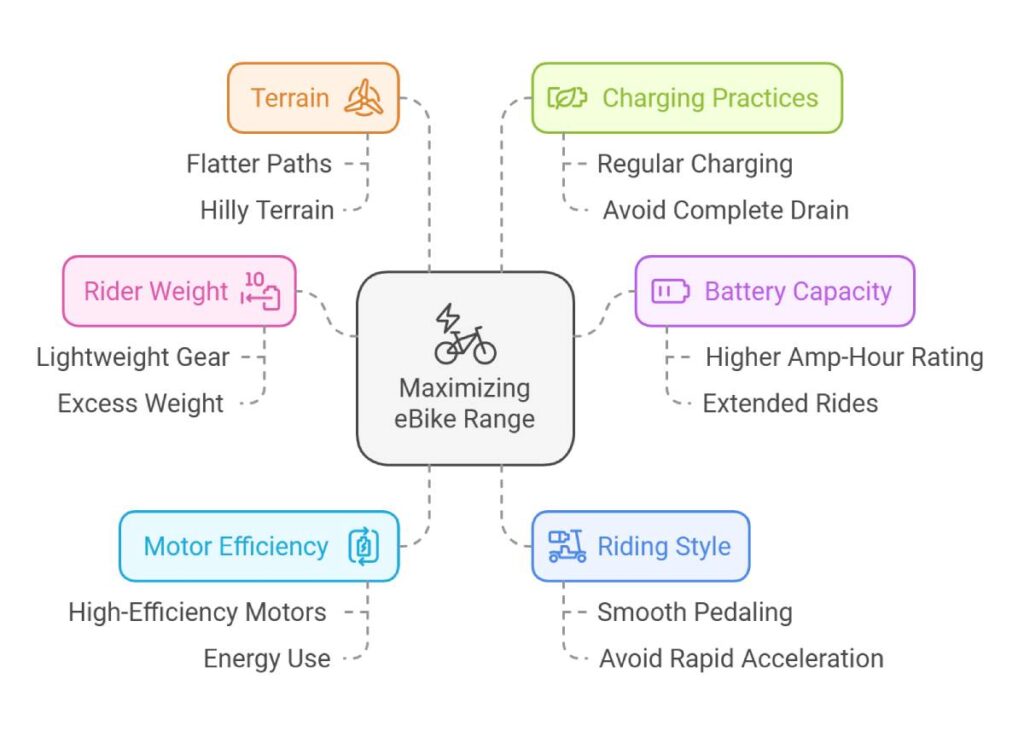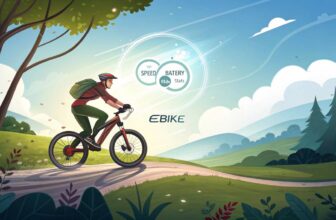Ready to supercharge your eBike adventures? 🚴♂️ Discover the hidden factors that determine your electric bike’s range and unlock longer smoother rides.
Whether you’re a daily commuter, a weekend explorer, or just curious about maximizing your eBike’s potential, understanding these key elements can transform your cycling experience.
From rider weight to battery capacity, we delve deep into what really affects how far you can go.
Buckle up and pedal into the secrets that will keep your eBike powered and your journeys endless!

Electric Bike Range Factors
Impact of Rider Weight
When it comes to electric bikes, size really does matter, but not in the way you might think. A heavier rider might feel like they’re puttin’ the brakes on their ride with slower speeds and a shrinking range. More weight means the motor’s gotta work overtime to keep things moving smoothly (HappyRun Sports). So, the skinny on acceleration, hill climbing, and all-around resistance is:
| Rider Weight | Motor Power | Battery Drain |
|---|---|---|
| 120 lbs | 250 – 500 watts | Moderate |
| 300 lbs | 500 watts and above | High |
If you’re on the heftier side, say tipping over 300 lbs, be prepared for your motor to guzzle more juice to keep up with those hills and speeds—your battery will deplete faster (SixThreeZero).
Influence of Battery Capacity
Think of battery capacity like a fuel tank, only geekier. It’s measured in watt-hours (Wh), and a bigger number means more energy, which can mean going the distance. Of course, how far you’ll actually travel can depend on your weight, where you ride, and how you roll (Isinwheel).
| Battery Capacity (Wh) | Estimated Range (Miles) |
|---|---|
| 500 Wh | 20 – 50 |
| 840 Wh | 40 – 60 |
Take the KBO Ranger, for instance—it packs an 840Wh battery, promising up to 60 miles on one full charge (KBO Bike).
Effect of Motor Efficiency
Your e-bike’s motor is like its heart, and if it beats efficiently, you’ll enjoy speed and distance without constantly scrambling for the charger. Check out how different motors stack up:
| Motor Type | Efficiency | Range Impact |
|---|---|---|
| Hub Motor | Moderate | Standard |
| Mid-drive Motor | High | Extended |
Getting the lowdown on these features helps city commuters and green-minded folks get the most pedal-pushing fun from their e-bikes. Wanna know more? Take a gander at our articles on electric bike battery care and how to charge your ebike.
Factors Affecting E-Bike Range
Various things affect how far your e-bike can get you on a single charge. Getting a grip on these can make a big difference in your ride. Let’s break down what’s really impacting your e-bike’s range: how you ride it, the path you take, and how you charge it up.
Rider Behavior and Riding Style
How you ride plays a major role in how long your e-bike keeps going. Messing around with the pedal assist settings based on what you need and where you are riding can change the battery life drastically. Cranking up the pedal assist on big hills gives you oomph but drains the battery quicker.
| Riding Style | Ride Length Impact |
|---|---|
| High Pedal Assist | Drains battery faster |
| Medium Pedal Assist | Keeps balance |
| Low Pedal Assist | Makes battery last longer |
Other things like how much you’re hauling, how often you stop and go, and the average speed you maintain can tweak the battery life too. A smooth and steady riding style usually saves power.
Terrain and Riding Conditions
The path you choose can play tricks on your e-bike’s range. Riding up and down hills or on bumpy trails will eat up more battery because of the extra effort needed to overcome the terrain. Weather’s in the mix too; a strong wind in your face sucks more juice, while having the wind at your back can help you go farther.
| Path Type | Battery Impact |
|---|---|
| Hilly Paths | Burns battery faster |
| Smooth/Paved Roads | Saves battery |
| Strong Headwinds | Drains battery |
| Tailwinds | Saves battery |
Keep these in mind when choosing your route to make sure you don’t run out of battery before you get back.

Battery Charging Practices
How you juice up your e-bike can really affect both its range and how long the battery lasts overall. The best bet? Charge it all the way up before heading out. Doing anything less regularly can chip away at how much power the battery can hold. Plugging it back in right after your ride keeps it from wearing out too quickly.
| Charging Habit | Ride Impact |
|---|---|
| Full Charge Before Riding | Keeps battery going strong |
| Immediate Recharge Post-Ride | Maintains battery health |
| Frequent Partial Charges | Wears it out over time |
Sticking to a routine for charging and using the right charger for your battery are key. Check out our electric bike battery care guide for more tips.
When you get the hang on these factors, you’ll be ready to cruise like a pro, whether you’re going on an urban commute, going green, or just zipping around for fun. Check out more of our tips on ebike classifications and ebike motor types if you’re curious!
E-Bike Battery Considerations
The battery acts as the heart and soul of your e-bike, and getting to grips with this gadget’s quirks can really up your ride game. Let’s jump into the nitty-gritty about battery life, weight, and how your riding habits can make or break your bike’s oomph.
Battery Capacity and Range
The size of an e-bike’s battery, usually shown in watt-hours (Wh), is a big deal because it tells you how far you can go on a single charge. More Wh means more juice in the tank and less worry about running out of power mid-trip. Take the KBO Ranger for example. Its beefy 840Wh battery can keep you rolling up to 60 miles, which is like a mini road trip on wheels (KBO Bike).
| Battery Capacity (Wh) | Estimated Range (Miles) |
|---|---|
| 250 Wh | 15 – 30 |
| 500 Wh | 30 – 60 |
| 750 Wh | 45 – 90 |
| 1000 Wh | 60 – 120 |
Check out our piece on electric bike battery care to get the full scoop on keeping your battery in tip-top shape.
Weight and Load Impact
When it comes to e-bikes, heft matters. A heavier bike and rider mean the battery’s working overtime to keep you cruising. Hills might feel like mountains, and you could find yourself slowing down sooner than later.
Here’s how to lighten the load on your battery:
- Pump those tires up, 75 to 80 psi should do, and feel the difference (SixThreeZero).
- Spread the weight evenly to avoid toppling over or stressing the battery more than needed.
Dive into our guide on electric bike weight limits for more savvy tips on managing your ride’s burden.
Riding Efficiency and Style
How you ride can make a massive difference in how far you can go. Gunning it from stoplights and playing racer can suck your battery dry faster than you think. Keeping a chill pace and picking the right assist levels can stretch your battery’s legs a bit longer (KBO Bike).
Top Tips for Getting the Most Out of Your Ride:
- Pedal at a consistent, smooth speed.
- Match your energy with the right pedal assist.
- Find routes that minimize stopping and starting.
For more on supercharging your ride’s efficiency, give our article on ebike display settings a whirl.
Knowing the ins and outs of your e-bike’s battery setup helps make every ride count. For more on keeping things running smoothly or fixing hiccups, head to our ebike troubleshooting guide.
Pedal Assist Impact
Pedal assist on e-bikes is the secret sauce that turns a good ride into a great one, making it easy-peasy to conquer long stretches without feeling like you’ve just completed a marathon. Here’s the lowdown on pedal assist levels, their perks, and how to tweak ’em for various terrains.
Understanding Pedal Assist Levels
Pedal assist levels go from 0 to 5, each giving you a different level of help from the motor.
| Level | Description | Best Use |
|---|---|---|
| 0 | No help | Save battery for when you really need it |
| 1 | Little help | Cruising on flat roads, taking it easy |
| 2 | Some help | Zipping through the city, minor hills |
| 3 | More help | Tackling those pesky hills |
| 4 | Extra help | Steep hills, long uphill battles |
| 5 | All the help | Mixed terrains, really tough rides |
Need a lift up a hill? Levels 3 and 4 got your back. For a super-duper push, crank it up to 5 when the road’s doing a rollercoaster street impression (BafangUSAdirect).
Benefits of Pedal Assist
What’s in it for you? Loads of good stuff:
- Longer Rides: Pedal assist helps stretch the battery life, letting you explore further without fear of your e-bike calling it quits. Need more battery tips? Dive into our electric bike battery care guide.
- Less Sweat: Pedal assist means less huffing and puffing—which is perfect if you’re riding to work in your snazzy workwear or if climbing a hill feels like climbing Everest to you (BafangUSAdirect).
- Fast and Furious: Go fast with less hard work, great for city commutes or delivery folks zooming from A to B.
- Custom Joyrides: Dial-in just the right level of assist to match your fitness and terrain, making every ride a joyride.
Adapting Pedal Assist to Terrain
Match your pedal power to the path for a smoother ride and a longer battery life:
- Flat Roads: Stick with levels 1 or 2 to keep some juice in the tank while still getting a pleasant nudge. Keep those tires firm and smooth to glide over the road effortlessly (KBO Bike).
- Going Up?: Crank it to levels 3 or 4 to make those hills shrink down to size. Wondering how your motor handles slopes? Peek at our ebike motor types guide.
- Mixed Bags: For terrains that change their mind, set pedal assist to 5. Tweak as you go to make the journey feel like a Sunday stroll.
- Tire Tricks: Pump those tires to 75-80 pounds to zip along with less resistance, especially if you’re carrying some extra cargo (SixThreeZero). Regular checkups and maintenance make a big difference. Take a gander at our electric bike maintenance tips.
Mastering pedal assist can turn you into an e-bike guru, making every ride a breeze. Don’t miss out on our ebike troubleshooting and electric bike group rides pages for even more ways to get the most out of your rides.
Terrain and Range Relationships
Figuring out how terrain plays into your e-bike’s battery life is a game-changer when it comes to making the most out of your electric ride. The ground you cover has a big say in how far you can cruise before needing to plug in and recharge.
Terrain Influence on Battery Range
When you think about what drains your e-bike’s battery, the landscape is a huge player. Climbing hills? Get ready to burn through more power since your motor has to work harder, chomping down on that battery juice (KBO Bike). Bumpy, uneven surfaces? They’re not doing you any favors either — they demand more from the motor, so you get less miles per charge.
| Terrain Type | Energy Consumption | Efficiency Impact |
|---|---|---|
| Hilly | High | Less Distance |
| Rough/Unpaved | High | Less Distance |
| Smooth/Paved | Moderate | More Distance |
Keep these in mind when plotting your path to squeeze every bit of energy out of that e-bike.
Tire Type and Rolling Resistance
Just when you thought tires were just tires — surprise! They make a big difference. Tires meant for off-road or rocky terrain? They’re like energy eaters compared to smooth road warriors. More friction equals more battery used, means you’re not going as far without needing a charge.
| Tire Type | Rolling Resistance | Efficiency Impact |
|---|---|---|
| Mountain/Rough | High | Less Distance |
| Smooth/Road | Low | More Distance |
You might want to pick your rubber wisely if you’re aiming to max out e-bike performance.
Uphill and Downhill Effects
Pedaling uphill? Say bye-bye to battery life pretty quick, as you’re making your motor hustle. On the flip side, coasting downhill or riding flat? Your battery thanks you, letting you go further before grabbing the charger.
Learning about how these slopes gobble up energy helps with e-bike maintenance and planning out those long joyrides. Keep an eye on battery levels with ebike display settings to tweak your ride and get smarter about energy use.
Tips for stretching your battery life include:
- Knock down the pedal assist when climbing.
- Keep it steady on the flats.
- Use regenerative braking if your e-bike’s got it.
For more scoops on e-bike stuff, check our coverage on mid drive vs hub motor ebike and electric bike maintenance.
Getting a feel for how the terrain and tire choices play into your ride means you’re better equipped to keep ’em rolling longer without a charge.
Power and Speed Factors
If you’re planning to zoom around on your electric bike (e-bike), knowing the ins and outs of power and speed can really amp up your ride. Let’s chat about what your motor’s got, how weight messes with your speed, and why faster means more juice drain on that battery.
Motor Strength Matters
Think of your e-bike’s motor as its muscle. A beefy motor means you can zip along faster and tackle those pesky hills without feeling like you’re back at the gym. Motors are usually measured in watts (W) – higher watts equals more oomph. Perfect for city cruisers and delivery riders who need to glide through streets without breaking a sweat.
| Motor Power (W) | Max Speed (mph) | Best For |
|---|---|---|
| 250W | 15 mph | Chillin’ and Relaxing |
| 500W | 20 mph | City Slickers and Green Gurus |
| 750W | 28 mph | Speedsters and Delivery Pros |
Curious about different types of motors? Check out e-bike motor types.
How Weight Plays with Speed
Extra pounds – whether from you, the bike, or your groceries – can slow the pace down. Heavier loads mean more time to get rolling, especially if you’re fighting those ever-present uphill battles.
| Weight (lbs) | Average Speed (mph) | Acceleration |
|---|---|---|
| <150 | 20 mph | Fast in a Flash |
| 150-200 | 18 mph | Cruiser Speed |
| >200 | 16 mph | Slow and Steady |
Understanding your e-bike’s carrying limits can help you keep cruising without a hitch (electric bike weight limits).
Battery Use When Fast and Furious
The faster you roll, the more your battery works its tail off. Zipping around drains power quicker, so your battery range takes a hit. How far you go depends on the motor’s grunt, battery size, and whether you’re riding over pancakes or mountains.
| Speed (mph) | Battery Drain (%) | Range (miles) |
|---|---|---|
| 15 | 10 | 50 |
| 20 | 20 | 40 |
| 25 | 30 | 30 |
Stay on top of regular check-ups (electric bike maintenance) to keep your e-bike in tip-top shape and stretch that battery life. Find more battery-saving tips at our electric bike battery care guide.
So next time you hop on your e-bike, remember these pointers to get the most out of your rides, whether you’re heading to work or just soaking up the sun. Happy riding!
Efficiency in Speed and Range
Getting the hang of how an e-bike’s speed and battery life are connected is a game-changer for city travelers, eco-friendly folks, and anyone else hopping on the e-bike trend. Let’s break down how getting up to speed, cruising, and being smart can stretch your electric bike’s range.
Acceleration and Battery Zap
E-bikes can zip off the line like your favorite sports car—perfect for city traffic or conquering hills with ease. But this speedy start-up does eat into the battery life, especially when you’re in stop-and-go situations.
| Situation | Battery Drain |
|---|---|
| Consistent, Smooth Speed | Low |
| Stop-and-Start Traffic | High |
| Going Uphill | Super High |
For those wanting to stretch every mile, keep it steady and skip the jackrabbit starts. Use your ebike display settings to keep an eye on how fast you’re going and how much juice you have left.
Speed versus Battery Life
Flying down the street at maximum speed definitely puts a dent in how far you’ll go before you need to recharge. Finding that middle ground between speed and battery longevity is the trick.
| Speed Level | Impact on Battery Life |
|---|---|
| Slow (5-10 mph) | Light Impact |
| Average (10-15 mph) | Medium Impact |
| Fast (15-20 mph) | Heavy Impact |
Everything from how strong your motor is to how big your battery is plays a role in how speed cuts into battery life. For extra tips, swing by electric bike battery care.
Optimal Speed for Efficiency
Figuring out the sweet spot for speed and juice gets the most out of your rides. Usually, a moderate pace means a good balance between getting where you’re going fast enough and not draining the battery dry. This is really important if you’re a delivery service rider or a senior enjoying a spin.
Ideal riding speeds can change depending on where you’re biking, how you handle the bike, and what your e-bike can do. Take a look at this table:
| Optimal Speed | Average Range Boost |
|---|---|
| 8-10 mph | 20-25% |
| 10-12 mph | 10-15% |
| 12-14 mph | 5-10% |
By staying savvy about these elements of speed and efficiency, you can personalize your rides and get the best out of your e-bike. Curious to learn more about handling your e-bike? Check out sections like ebike motor types and electric bike maintenance.
Conclusion
Maximizing your eBike’s range isn’t just about having a powerful battery or a robust motor—it’s a harmonious blend of various factors working together. Understanding how your weight influences motor performance, choosing the right battery capacity, and maintaining motor efficiency are foundational to longer rides.
Additionally, your riding style plays a crucial role; adopting a smooth and consistent approach can significantly extend your battery life. Navigating different terrains requires strategic use of pedal assist levels and being mindful of environmental conditions like wind and road quality.
Equally important are your charging habits—regularly fully charging your battery and avoiding frequent partial charges can enhance its longevity.
By mastering these elements, you not only improve your eBike’s performance but also enjoy a more reliable and enjoyable cycling experience. Whether you’re commuting through the city, exploring off-road trails, or simply enjoying leisurely rides, these insights empower you to get the most out of your eBike.
Dive deeper into our guides on battery care, motor types, and maintenance tips to continue elevating your eBike adventures. Ride smart, stay powered, and let your eBike take you further than ever before!
FAQs
What factors most significantly affect an eBike’s range?
Several factors impact an eBike’s range, including rider weight, battery capacity, motor efficiency, riding style, terrain, and charging practices. Understanding and optimizing these can help extend your ride.
How does rider weight influence eBike performance?
Heavier riders require more motor power to maintain speed and tackle hills, which can lead to increased battery drain and reduced overall range.
What is the importance of battery capacity in an eBike?
Battery capacity, measured in watt-hours (Wh), determines how much energy your eBike can store. Higher capacity batteries provide longer ranges, allowing for extended rides without needing to recharge.
How can I extend my eBike’s battery life?
To extend battery life, maintain consistent riding speeds, use appropriate pedal assist levels, avoid extreme temperatures, and follow proper charging practices, such as fully charging before rides and avoiding frequent partial charges.
What role does terrain play in eBike range?
Challenging terrains like hills and rough trails require more motor power, which increases battery consumption and reduces range. Smooth, paved roads are more energy-efficient and help extend your eBike’s battery life.
Final Thoughts
Navigating the world of eBikes can be exhilarating and a bit overwhelming, but understanding the key factors that influence your bike’s range empowers you to make informed decisions and enjoy every ride to the fullest.
From managing your rider weight and optimizing battery capacity to mastering pedal assist settings and adapting to various terrains, each element plays a crucial role in enhancing your eBike experience.
Remember, it’s not just about having the most powerful motor or the largest battery; it’s about finding the right balance that suits your lifestyle and riding habits. Regular maintenance and mindful charging practices further ensure that your eBike remains reliable and efficient for years to come.
At MyBikeReview.com, we’re dedicated to providing you with the insights and resources you need to make the most out of your electric biking adventures. Whether you’re a seasoned rider or just starting out, our comprehensive guides and expert tips are here to support you every pedal of the way.
So gear up, ride smart, and let your eBike take you on countless unforgettable journeys!
Key Tips
- Optimize Battery Usage: Use lower pedal assist levels on flat terrains to conserve battery life.
- Maintain Proper Tire Pressure: Keep tires inflated to the recommended PSI to reduce rolling resistance and enhance efficiency.
- Balance Your Load: Distribute weight evenly on your eBike to minimize strain on the motor and battery.
- Choose Efficient Routes: Select paths with fewer hills and smooth surfaces to extend your riding range.
- Regular Maintenance: Keep your eBike in top condition with routine checks on the battery, motor, and tires.
- Smart Charging Practices: Fully charge your battery before long rides and avoid letting it drain completely.
- Adjust Riding Speed: Maintain a steady, moderate speed to balance performance and battery longevity.
- Use Regenerative Braking: If available, utilize regenerative braking to recover some energy during stops and downhill rides.
Recommended Biking Products and Accessories
- KBO Ranger 840Wh Battery Pack
- Enhance your eBike’s range with this high-capacity battery, perfect for long-distance rides.
- SixThreeZero High-Pressure Bike Pump
- Maintain optimal tire pressure with this reliable pump, ensuring better efficiency and longer range.
- Bafang Mid-Drive Motor Upgrade Kit
- Boost your eBike’s performance with this efficient mid-drive motor, ideal for tackling varied terrains.
- Isinwheel Smart Battery Monitor
- Keep track of your battery’s health and usage with this advanced monitoring system.
- Electric Bike Regenerative Brake System
- Extend your battery life by recovering energy during braking with this innovative system.
- KBO Ranger Durable eBike Tires
- Ensure a smooth ride on any terrain with these high-performance tires designed for eBikes.
- Bafang USA Direct Pedal Assist Controller
- Customize your pedal assist levels for optimal performance and range with this controller.
- MyBikeReview.com Electric Bike Maintenance Kit
- Keep your eBike in top shape with this comprehensive maintenance kit, including tools and guides.
By implementing these enhancements, your article will not only engage readers more effectively but also align with SEO best practices, driving more traffic and providing valuable information to your audience.




